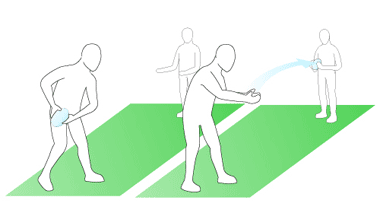Welcome to our rugby passing guide on TalkRugbyUnion. With our guide, you’ll come to understand the fineties of passing in rugby like you’ve been playing the sport all your life!
Passing is one of the fundamental techniques in rugby union used to move the ball down the pitch towards the try-line whilst maintaining speed and motion. There are various types of passes which players use, depending on their position, the amount of power required and the direction the ball is being passed. Whilst players can move across the pitch in any direction, they may only pass the ball to their side or behind them and will be penalised for passing forwards.
The best rugby union teams are those who pass the ball frequently and accurately in order to change the point of attack and make tackling and defence difficult for the opposing players. In order to protect the ball carrier when making and receiving passes and increasing the chance of overpowering the defence and scoring a try, other players should act as support at all times, running close to the player, allowing them more chance of retaining the ball in an attack.
There are various types of passes which all rely on the same principles. All passes require accuracy, good height and the optimum amount of power in order to keep the ball moving in the direction of the goal lines without the player being forced to run sideways or slow down, both of which can make them more susceptible to attack.
To execute an effective pass, the player must carry the ball in two hands at chest height, spreading their fingers around the seams of the ball and keeping the palms of their hands away from the ball’s surface to protect the ball from attack when running.
When making a pass, the player should look at the player waiting to receive the ball in order to ensure the ball is passed in an accurate direction. Keeping their elbows bent, the player should then swing their arms across the body, drawing the ball across one hip. With the elbows staying close to the body, the player should swing the ball in an arc, off the hip and towards the receiver, their chest turned in the opposite direction. The player should then push the ball with their back hand, guiding the ball with the front hand in the correct direction. As the ball leaves the hand, the player should flick their wrists and point towards the target, changing their running angle to support the receiver as they continue in the direction of the goal lines.
The main passes used in rugby union are as follows:
The Lateral Pass
Also known as ‘the sideways pass’, the lateral pass is the most basic pass in rugby union, used for middle distance sideways and backwards throws. It is crucial that the lateral pass is made at chest height to prevent the receiver from having to look down and take their eyes of the defence.
The Pop Pass
A variation of the lateral pass, the pop pass is used for short, close-distance passes, requiring the player to use power from their forearms and throw the ball with only a slight flick of the wrist, rather than a swing across the body as is required for longer passes.
Switch Pass
The switch pass aims to change the direction of play by confusing the opponent (who will expect the ball to be passed in the same direction as it was travelling prior to the pass) and opening up a space for other members of the team to run through.
The Loop Pass
The loop pass allows the player more options when the defence is preventing them from passing to a desired position. The ball carrier passes the ball to a player close by, runs a loop around the next ball carrier and enters the line in a better position, effectively allowing the player an extra pair of hands. This requires great speed to prevent the defence from anticipating the player’s move and obstructing their path.
The Dummy Pass
A technique used to trick an opponent, the dummy pass requires the player carrying the ball to feign a passing motion, sending the defence over to the supposed target player and allowing the ball carrier a window of opportunity to sprint away from the defence. Players should be wary of overusing the dummy pass in order to prevent the defence from anticipating the pass.
The Overhead Pass
Used when a ball is kicked into touch (out of the field of play) and a line-out (throw-in) is taken. The player on the touch-line throws the ball with two hands over their head in order to build up enough power to allow the ball to travel at least 5 metres to the waiting players in the line-out.
